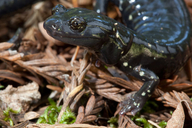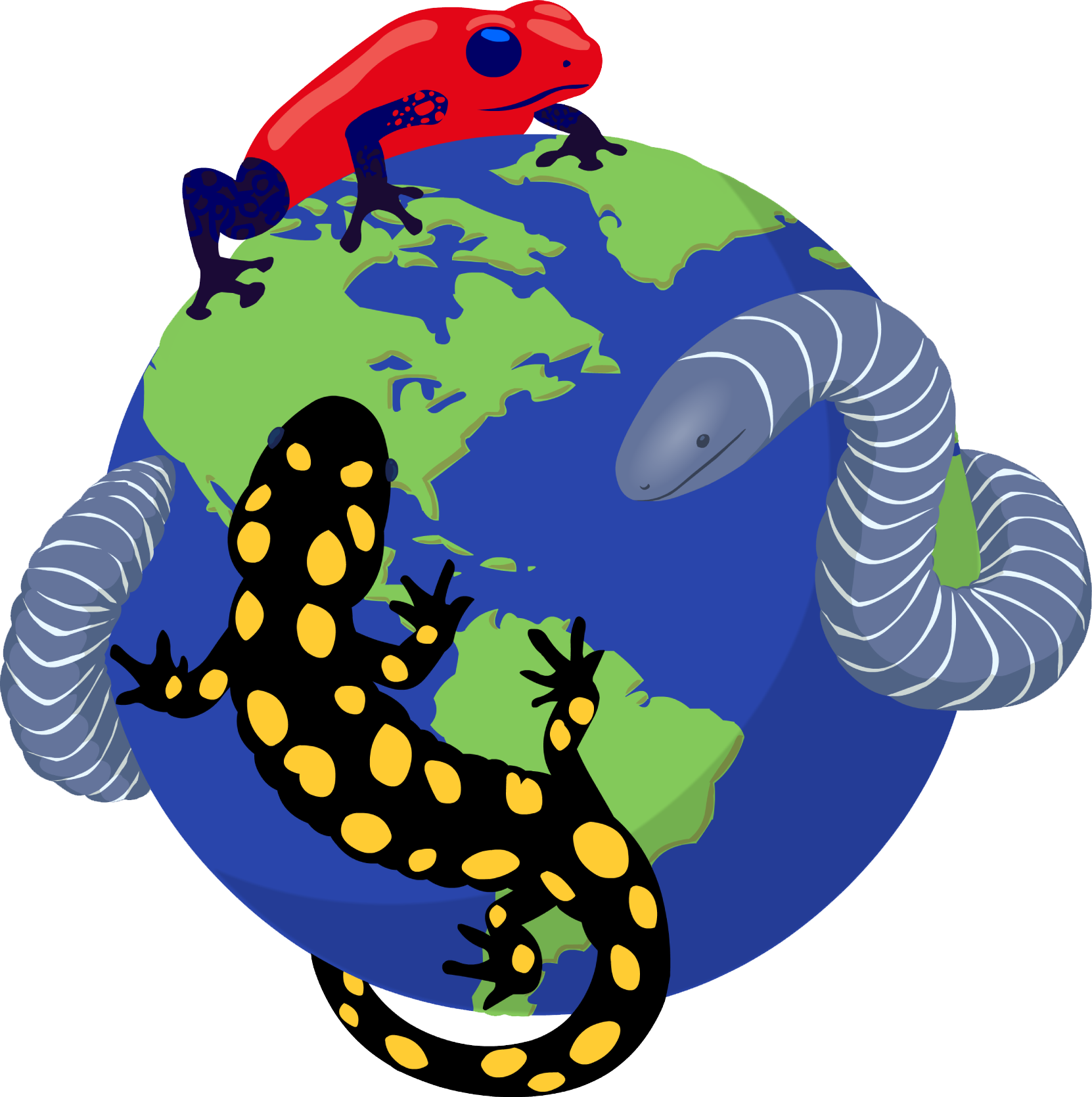|
Aneides flavipunctatus (Strauch, 1870)
Black Salamander, Speckled Black Salamander Subgenus: Aneides | family: Plethodontidae subfamily: Plethodontinae genus: Aneides |
| Species Description: Strauch, A. (1870). "Revision der Salamandriden-Gattungen nebst beschreibung einiger neuen und weniger bekannten Arten dieser Familie." Mémoires de l'Académie Impériale des Sciences de St. Pétersbourg. Série 7, 16 (4): 1–110. | |
|
Taxonomic Notes: Reilly & Wake (2019, PeerJ), building on earlier papers by Rissler & Apodaca (2007, Syst Biol 56: 924-942) and Reilly & Wake (2015, J Biogeog 42: 280-291), revised the taxonomy of a species complex and recognized four species: A. flavipunctatus (which has the greatest geographic range and is the most variable in morphology and molecular markers), A. iecanus, A. klamathensis and A. niger. |
|
 © 2010 Gerold Merker (1 of 71) |
|
|
|
Description Aneides flavipunctatus is a large, robust salamander with some individuals being greater than 80 mm. Their standard length ranges from 64.0 - 80.3 mm for males and 63.3 - 78.1 mm in females. It has a robust, rounded head that expands laterally behind the eyes, particularly in males. The jaws are very muscular. The robust limbs and digits are shorter than most Aneides but are moderately long. The number of costal grooves between adpressed limbs range from 1 - 4. The tails are moderately long, 87 - 94% of the standard length (Reilly and Wake 2019). Projecting upper-jaw teeth and triangular head distinguish the Black Salamander as a climbing salamander of the genus Aneides (Dunn 1926). Aneides flavipunctatus was split into four species in 2019 (Reilly and Wake). Those species are A. flavipunctatus, A. iecanus, A. klamathensis, and A. niger . Each of these species occupies a different range and the coloration of A. flavipunctatus further differentiates them. Aneides flavipunctatus has more color variation than all of the other species, and can be further differentiated by having more frost dorsal coloration than A. klamathensis and more iridophores than A. niger. Unfortunately, living A. flavipunctatus cannot be easily distinguished from A. klamathensis in their inland contact zone near Latonville, California. From more distantly related Aneides, A. flavipunctatus is larger than A. aeneus, A. ferreus, A. hardii, and A. vagrans and smaller than A. lugubris. Having a robust, and minimally prehensile tail further separates A. flavipunctatus from A. ferreus, A. lugubris, and A. vagrans, which all have more prehensile tails. The blackish background coloration of A. flavipunctatus sets it apart from the greenish A. aeneus and the lighter A. lugubris. A robust head, body, and tail differentiates A. flavipunctatus from A. aeneus, and A. hardii. Lastly, shorter limbs and digits distinguishes A. flavipunctatus from A. aeneus, A. ferreus, A. lugubris and A. vagrans (Reilly and Wake 2019). Coloration: Aneides flavipunctatus has a black background color with minute pale yellow, white, or cream-colored spots throughout (Stebbins 1985, Reilly and Wake 2019). Variation: Coloration and patterning of Aneides flavipunctatus in the Longvale/Laytonville region of Mendocino County, California is highly variable and these individuals are difficult to distinguish from A. klamathensis, which they overlap with. This contact zone requires further investigation (Reilly and Wake 2019). Distribution and Habitat Country distribution from AmphibiaWeb's database: United States U.S. state distribution from AmphibiaWeb's database: California, Oregon
Life History, Abundance, Activity, and Special Behaviors Typically an egg clutch is found with a female in attendance. In the laboratory, females stayed with their clutches until eggs hatched (N. L. Staub, personal observation). Abundance. Black salamanders were once considered common in many areas of their range, but have become rare in recent years (D. B. Wake, in Petranka 1998). The proliferation of vineyards in northern California has destroyed much of the black salamander’s prime habitat (personal observation). Behavior. In captivity, adults often bite one another (e.g., Myers 1930) and adult males and females show agonistic behavior toward intruders (Staub 1993). Animals captured in the field are frequently scarred; males show a higher frequency of scarring than do females (Staub 1993). This species may be territorial in the field. Aestivation. In southern populations that are associated with streamside habitats, black salamanders are active year round. In habitats which are not associated with permanent water, salamanders move underground during the dry season (mid-April – mid-October) (Lynch 1974). Interspecific Associations/Exclusions. Black salamanders occur syntopically with clouded salamanders (Aneides ferreus), wandering salamanders (Aneides vagrans), arboreal salamanders (Aneides lugubris), ensatinas (Ensatina eschscholtzi) and California slender salamanders (Batrachoseps attenuatus) (Lynch 1974, 1985; Myers and Maslin 1948; Wood 1936). Black salamanders also occur extensively with Plethodon elongatus in the Klamath River Valley and Trinity River drainage. Feeding Behavior. Juveniles and adults feed on a wide variety of prey. The diet of adult salamanders consists primarily of diplopoda (millipedes), coleopterans, formicans (primarily ants), and isopterans (primarily termites) (Lynch 1985). The diet of juveniles includes these prey as well as dipterans and collembolans (Lynch 1985). Larger individuals consume larger prey items; mean and maximum prey size is correlated with body size. This correlation suggests that larger animals are selecting larger prey items and are ignoring smaller prey items. The number of prey items decreases as body size increases (Lynch 1985). Predators. Predators include western terrestrial garter snakes (Thamnophis elegans; Lynch 1981). Anti-Predator Mechanisms. When startled, juveniles generally remain immobile and adults flee (Van Denburgh 1895; Jones 1984). Other escape or defense behaviors include jumping (Van Denburgh 1895), the production of sticky skin secretions (Lynch 1981), an agonistic posture, and agonistic behaviors including biting (Lynch 1981; Staub 1993). The agonistic posture of the black salamanders is distinctive. The animal raises its body off the substrate with the legs fully extended, the back is arched, the head elevated with the snout pointed slightly downward, and the tail undulates (Jones 1984; Staub 1993; Stebbins 1954). In the laboratory, A. flavipunctatus will bite western garter snakes which can result in serious injuries (Lynch 1981). Parasites. Nematodes have been found in the black salamander (Lehmann 1954; Schad 1960). Life Expectancy: Staub (2016) reviews evidence of life expectancy for salamanders of the family Plethodontidae, and concludes that these generally small animals can attain relatively great age. The most direct evidence is from captive animals, and members of Plethodon, Aneides and Phaeognathus, among others, have attained ages in excess of 30 years (the individual in the photograph was collected as an adult in April 1985, and is still apparently in robust health). In a separate field study (Staub 2016), Aneides flavipunctatus longevity was estimated to be on the order of 18 or 25 years, using different methods. Other field estimates also show long lives, as great as 32 years. Methods tend to be conservative, and some individuals might be substantially older. Larva Trends and Threats Comments It is assumed that the species epithet, "flavipunctatus", is reference to the light spots on the holotype that the species authority, Strauch (1870), assumed were yellowish instead of their cream-colored spots in life (Reilly and Wake 2019). See other subspecies accounts at www.californiaherps.com: A. flavipunctatus.
References
Dunn, E. R. (1926). The Salamanders of the Family Plethodontidae. Smith College, Northhampton, Massachusetts. Jones, L. L. C. (1984). ''Life history notes: Aneides flavipunctatus flavipunctatus (Speckled Black Salamander). Behavior.'' Herpetological Review, 15(1), 17. Larson, A. (1980). ''Paedomorphosis in relation to rates of morphological and molecular evolution in the salamander Aneides flavipunctatus.'' Evolution, 34(1), 1-17. Lehmann, D. L. (1954). ''Some helminths of the West Coast urodeles.'' Journal of Parasitology, 40, 231. Lynch, J. F. (1974). ''Aneides flavipunctatus.'' Catalogue of American Amphibians and Reptiles. Society for the Study of Amphibians and Reptiles, 158.1. Lynch, J. F. (1981). ''Patterns of ontogenetic and geographic variation in the Black Salamander, Aneides flavipunctatus.'' Smithsonian Contributions to Zoology, (324), i-iv, 1-53. Lynch, J.F. (1985). "The feeding ecology of Aneides flavipunctatus and sympatric plethodontid salamanders in northwestern California." Journal of Herpetology, 19, 328-352. Myers, G.S. (1930). "Notes on some amphibians in western North America." Proceedings of the Biological Society of Washington, 43, 55-64. Myers, G.S. and Maslin, T.P., Jr. (1948). ''The California plethodont salamander, Aneides flavipunctatus (Strauch), with descriptions of a new subspecies and notes on other western Aneides.'' Proceedings of the Biological Society of Washington, 61, 127-128. Nussbaum, R. A., Brodie, E. D., Jr., and Storm, R. M. (1983). Amphibians and Reptiles of the Pacific Northwest. University of Idaho Press, Moscow, Idaho. Petranka, J. W. (1998). Salamanders of the United States and Canada. Smithsonian Institution Press, Washington D.C. and London. Rissler, L. J., and Apodaca, J. J. (2007). ''Adding more ecology into species delimitation: ecological niche models and phylogeography help define cryptic species in the black salamander (Aneides flavipunctatus).'' Systematic Biology, 56, 924-942. Schad, G. A. (1960). ''The genus Thelandros (Nematoda: Oxyuroidea) in North American salamanders, including a description of Thelandros salamandrae.'' Canadian Journal of Zoology, 38, 115-120. Staub, N.L. (1993). ''Intraspecific agonistic hehavior of the salamander Aneides flavipunctatus (Amphibia: Plethodontidae) with comparisons to other plethodontid species.'' Herpetologica, 49, 271-282. Staub, Nancy (2016). ''The Age of Plethodontid Salamanders: A Short Review on Longevity.'' Copeia, 104(1), 118-123. Staub, Nancy (2016). ''Age, Sexual Dimorphism, and Growth Rates in the Black Salamander, Aneides flavipunctatus (Plethodontidae).'' Copeia, 104(1), 52-59. Stebbins, R. C. (1954). Amphibians and Reptiles of Western North America. McGraw-Hill, New York. Stebbins, R. C. (1985). A Field Guide to Western Reptiles and Amphibians. Houghton Mifflin, Boston. Stebbins, R.C. (1951). Amphibians of Western North America. University of California Press, Berkeley. Van Denburgh, J. (1895). "Notes on the habits and distribution of Autodax iecrus." Proceedings of the California Academy of Science, 5, 776-778. Wood, W.F. (1936). ''Aneides flavipunctatus in burnt-over areas.'' Copeia, 1936(3), 171. Originally submitted by: Nancy L. Staub and David B. Wake (first posted 1999-02-28) Description by: Ann T. Chang (updated 2022-10-19)
Distribution by: Ann T. Chang (updated 2022-10-19)
Comments by: Ann T. Chang (updated 2022-10-19)
Edited by: Kellie Whittaker, David Wake and Sierra Raby, Ann T. Chang (2022-10-19) Species Account Citation: AmphibiaWeb 2022 Aneides flavipunctatus: Black Salamander <https://amphibiaweb.org/species/3936> University of California, Berkeley, CA, USA. Accessed Jan 31, 2025.
Feedback or comments about this page.
Citation: AmphibiaWeb. 2025. <https://amphibiaweb.org> University of California, Berkeley, CA, USA. Accessed 31 Jan 2025. AmphibiaWeb's policy on data use. |



 Raffaëlli Account
Raffaëlli Account Map of Life
Map of Life